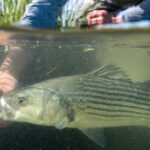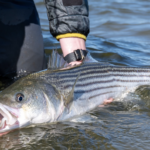
What to Watch for: ASMFC Spring Meeting
The Atlantic States Marine Fisheries Commission (ASFMC) will gather in Arlington, Virginia this week for the
The Young of the Year numbers came out yesterday and it was a dismal report. Not “below average” not just “one bad year” but rather another failure in recruitment and don’t let anyone tell you something different.

We don’t know how long you have been following striped bass management. There are some relevant issues in the not so distant past that should not be forgotten.
Back in 2012, the stock assessment for striped bass came out and showed a steep decline in SSB. The data predicted the SSB would be officially overfished within a few years if we continued the same rate of harvest.
We should have taken a +30% reduction in harvest then. But, the 2011 YOY numbers came out and showed the 4th best spawning year of all time. The managers used this as leverage to whittle down the reduction.
In the end, we took 25% on the coast and 20.5% in the Chesapeake. It was suggested that the Chesapeake stock is mostly male and therefore could be fished harder than the coastal stock. The result of that political shell game? The 2011 year class was utterly decimated and did not recruit to the SSB. Half a decade after the cuts were implemented, we are worse off than we were before and it is 100% due to overharvest. Guess that “male fishery” thing didn’t play out too well?
The press release yesterday does not spell the end for stripers. They do spawn in boom and bust cycles. Cold, wet springs are the recipe for good recruitment. It should be noted the spring of 2019 was one of the wettest on record
Our plea to the managers up and down the coast is simple. If a robust year class gave you the wiggle room to ease reductions in 2012, then the equal and opposite reaction would be that this YOY report should cause you to take a precautionary approach.
Finally, if the 2015 year class does not recruit to the SSB, we will be in deep trouble. You can not let Maryland repeat the history of the 2011 year class. We need to be more conservative. If we spent half the time trying to save the fish as we do trying to skew the statistics to continue unsustainable harvest levels, we wouldn’t be in this mess.
If they used a great YOY to mitigate science-based reductions, doesn’t it make sense that a bad YOY should have the equal and opposite reaction? We are awaiting their decision on the 30th.

The Atlantic States Marine Fisheries Commission (ASFMC) will gather in Arlington, Virginia this week for the

Consistent spawning production is paramount to a fishery’s long-term health. Many environmental factors are suspected

While the ASGA team is extremely proud of the community we’re building with the Guide

Feature Image: A false albacore being landed off Jupiter Florida by the Cheeky Fishing team,
We rely on our members and donations to keep fighting for a sustainable tomorrow in marine conservation.
By using this website, you agree to our use of cookies. We use cookies to provide you with a great experience and to help our website run effectively. To learn more, please review our privacy policy.
11 Responses
The ages-old problem of over-harvesting resulting in a diminished fishery is entirely driven by commercial market based greed. This has been true on land with both animals and birds and in the water with our fisheries. The only effective way to combat this self-perpetuating circle of repetitive failure is to eliminate commercial harvesting. It is wildlife/fishery management 101 not rocket science. When a species is managed as a game species the goals are species abundance and quality. When managed for commercial interests the results are greed-based over harvesting resulting in species degradation. As long as folks care more about their own selfish interests ahead of the welfare of the species in question it becomes a lose lose situation. Just look at the once abundant marine resources and how poorly they have universally failed under the mismanagement of today’s commercially biased regulators. To truly save the stripers and not have to keep fighting tooth and nail for their survival we need to support making them a game species….. just like every other species that has been threatened by commercial over-exploitation and been saved by eliminating commercial lobbying pressure on those responsible for – and here-in lies the elephant in the room – responsible for what: The selfish, short-term and myopic interests of the commercial lobby or the best interests of the striped bass? Seems to me the results of the on-going and current status management priorities tells us that the bass are losing. The ASGA should be out in front of the effort to make Stripers a game species.
Dean Clark,
I’d love to see striped bass given game fish status, but I don’t think the numbers show that commercial fishing is the biggest problem the fishery faces. According to the asmfc, we recreational fishermen account for about 90% of striped bass mortality between recreational landings (42%) and recreational release mortality (48%!!!). It’s easy to point the finger at commercial fishermen, but the numbers simply don’t support that argument. There are a lot of factors that impact the fishery. The science shows that recreational fishing is by far the most significant.
You are 100% correct: “…commercial fishing is (not) the biggest problem the fishery faces.”
I think you may have missed the main point that supports favoring game status for stripers…. or deer or grouse or ducks etc. etc. “When managed for commercial interests the results are greed-based over harvesting resulting in species degradation. As long as folks care more about their own selfish interests ahead of the welfare of the species in question it becomes a lose lose situation.”dc
There is no question about which sector does the most of the killing but who is doing the killing is not the issue. Dead is dead! What matters is: FOR WHAT PURPOSE IS THE SPECIES BEING MANAGED FOR? If it is for maximum exploitation which is the case when managing for commercial interests such as stripers are, it nearly always results in species degradation…. as is and has been the case with stripers. However, when a species is managed for recreational goals, conservation and abundance, the results are species enhancement.
Look at redfish, snook, and the many hundreds of other species that have been taken off the commercial table and designated as game species to both protect them from over harvesting and to provide recreation for millions of folks not just the few hundreds that sell stripers – a public resource – for personal profit.
But, THE KEY QUESTION IS it is not who is doing the killing. The bigger issue is to understand that the present goals of striped bass management is to please two polar opposite interests: The recreational sector that wants a long-term, healthy, abundant and quality fishery which equates to more fish in the bio-mass and thus more recreational success and the commercial sector that always wants to harvest more thus reducing/degrading the species. This is a classic example of the managers trying to serve two masters who have opposing views of how the job should get done.
Because commercial interests have always and still do control the management pendulum stripers have been degraded ever since the first European settlers came here. We can all agree that the species is only a shadow of what it once was. However, when a species is managed for the recreational sector, because their interests/goals are for greater abundance and quality, a species thrives….. This management dictate has been proven over and over again.
The question should not be sidetracked and confused by which sector does the most killing. …. there are millions of recreational fishermen and only a comparatively small handful of commercial fishermen. However, that argument obfuscates the real issue and allows those in charge to continue managing stripers for the benefit of the politically more powerful users – the commercial sector.
No, the real issue and the one that the ASGA should be exposing and espousing, is not which sector should be allocated how many fish to kill but instead WHICH MANAGEMENT GOAL WILL MOST BENEFIT THE SPECIES….. not which user benefit should prevail. The focus needs to be on the fish and not the fishermen.
Cutting the baby in half, which is what is happening now, is not the answer. We should instead all be advocating for a healthy baby (striped bass) first and foremost. Only when management focuses on the welfare off the striper ahead of the selfish greed of the user sectors will the stripers be protected – as a game species – from over harvesting.
You are 100% correct: “…commercial fishing is (not) the biggest problem the fishery faces.”
I think you may have missed the main point that supports favoring game status for stripers…. or deer or grouse or ducks etc. etc. “When managed for commercial interests the results are greed-based over harvesting resulting in species degradation. As long as folks care more about their own selfish interests ahead of the welfare of the species in question it becomes a lose lose situation.”dc
There is no question about which sector does the most of the killing but who is doing the killing is not the issue. Dead is dead! What matters is: FOR WHAT PURPOSE IS THE SPECIES BEING MANAGED FOR? If it is for maximum exploitation which is the case when managing for commercial interests such as stripers are, it nearly always results in species degradation…. as is and has been the case with stripers. However, when a species is managed for recreational goals, conservation and abundance, the results are species enhancement.
Look at redfish, snook, and the many hundreds of other species that have been taken off the commercial table and designated as game species to both protect them from over harvesting and to provide recreation for millions of folks not just the few hundreds that sell stripers – a public resource – for personal profit.
But, THE KEY QUESTION IS it is not who is doing the killing. The bigger issue is to understand that the present goals of striped bass management is to please two polar opposite interests: The recreational sector that wants a long-term, healthy, abundant and quality fishery which equates to more fish in the bio-mass and thus more recreational success and the commercial sector that always wants to harvest more thus reducing/degrading the species. This is a classic example of the managers trying to serve two masters who have opposing views of how the job should get done.
Because commercial interests have always and still do control the management pendulum stripers have been degraded ever since the first European settlers came here. We can all agree that the species is only a shadow of what it once was. However, when a species is managed for the recreational sector, because their interests/goals are for greater abundance and quality, a species thrives….. This management dictate has been proven over and over again.
The question should not be sidetracked and confused by which sector does the most killing. …. there are millions of recreational fishermen and only a comparatively small handful of commercial fishermen. However, that argument obfuscates the real issue and allows those in charge to continue managing stripers for the benefit of the politically more powerful users – the commercial sector.
No, the real issue and the one that the ASGA should be exposing and espousing, is not which sector should be allocated how many fish to kill but instead WHICH MANAGEMENT GOAL WILL MOST BENEFIT THE SPECIES….. not which user benefit should prevail. The focus needs to be on the fish and not the fishermen.
Cutting the baby in half, which is what is happening now, is not the answer. We should instead all be advocating for a healthy baby (striped bass) first and foremost. Only when management focuses on the welfare off the striper ahead of the selfish greed of the user sectors will the stripers be protected – as a game species – from over harvesting.
Dean,
It is abundantly clear that you are a spokesperson for Stripers Forever.
1) ASGA is based on one simple concept across all species. “If you take care of the fish, the fish take care of you.” This is what every position, every effort is based upon.
2) You don’t get to tell us what to do. Not sure who told you you could but they were wrong.
3) This is our platform. I have been very understanding of letting you push your agenda on it.
We prefer to never get into allocation issues. Essentially, you are advocating taking away from someone else. That isn’t putting the resource first.
It must be scary when a new group comes along that isn’t a one-trick pony and takes the fishery world by storm. We have not been critical of Stripers Forever. Honestly, I don’t have the time. But, you are no longer allowed to push your agenda on something we built. We do not believe in what you are doing. You do not get to tell us what we should be doing. We know infinitely more about the multi-species fishery policy at the highest levels of our government.
The world isn’t fair. I am the admin and can approve, delete, etc comments. I would never go on a stripers forever website and push our agenda. It is bad form.
Consider this a friendly reminder of etiquette.
I was writing as a concerned individual and not as a spokesperson for Stripers Forever which is why I never mentioned Stripers Forever’s name. Thank you for the polite reprimand re etiquette. I apologize if it appeared that I was trying to tell ASGA what to do or to hijack this thread. My intentions were to suggest that that since advocating for the fish instead of the fishermen was the primary objective of ASGA, that avoiding the underlying factors behind management’s objectives was counter-intuitive as it deflects the discussion away from the true causes of over-harvesting. Again, I apologize if I expressed a viewpoint that you don’t agree with and one that was inappropriate for this forum.
I was and am writing as a concerned individual and not as a spokesperson for Stripers Forever which is why I never mentioned Stripers Forever’s name. Thank you for the polite reprimand re etiquette. I apologize if it appeared that I was trying to tell ASGA what to do or to hijack this thread. My intentions were to suggest that that since advocating for the fish instead of fishermen was the primary objective of ASGA, that avoiding the underlying factors behind management’s objectives was counter-intuitive as it deflects the discussion away from the true causes of and thus solutions to over-harvesting. Again, I apologize if I expressed a viewpoint that you don’t agree with and one that was inappropriate for this forum.
Dear Admin (who shall remain nameless), this is part of the problem. Groups such as ASGA and Stripers Forever, at their core, have the same goals in mind; an abundance of Striped Bass. You just have a difference of opinion on how to achieve that goal. Meanwhile, other, more singularly focused groups have a louder voice at the table and can sway the ASMFCs decision making process in their favor. Perhaps both groups (and the fishery itself) would benefit from a more cooperative approach that seeks to come up with some common recommendations for managing for abundance. I think the ASMFC’s decision this week to recommend a slot limit is a direct result of the fact that we recreational anglers don’t present a strong and unified front regarding our wishes for the fishery.
IMO, the decision to go with the 28-35 inch slot limit is effectively the same as a “status quo” approach. What percentage of the keeper fish that were caught this year were bigger than 35 inches? I don’t know the answer to that, but I’d bet it is less than 18%. So, simple math says that unless 18% of the fish were over 35 inches, there’s no way we will achieve an 18% reduction in harvest.
I can’t disagree with that Tom. Btw, my name is Tony Friedrich. I am the VP/Policy Director for ASGA. No one is trying to hide behind the “admin” tag. Essentially, I have to stay logged in as admin to moderate the comments and edit the site.
I also agree that the decision is pretty much “status quo”.
The association takes no issue with Stripers Forever. What we do take issue with is folks telling us how we have it wrong and advocating for their group’s position on this forum.
We are all for open discussion. But, it is bad form to criticize our position on our website while extolling the virtues of another position when you are active/officer/board in the other group. Like… Why not send an email or call?
Thanks. Keep up the good work. You guys are doing a great job of educating the angling public about the problems our fisheries face.
sorry for the duplicate reply…..
dc